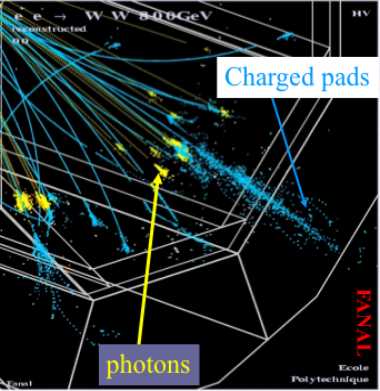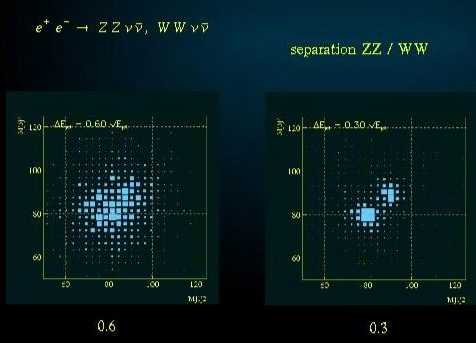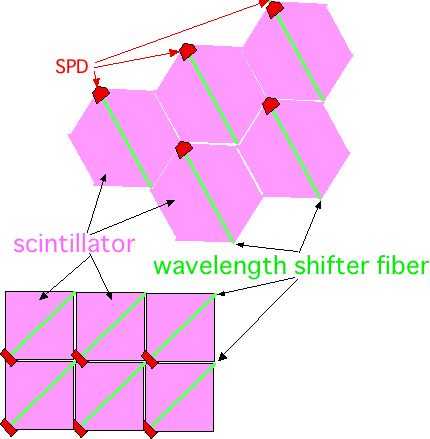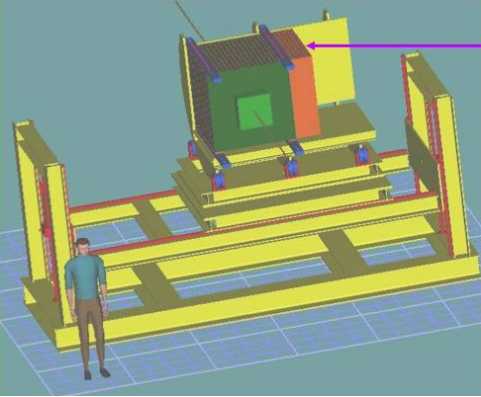Digital H-CAL at first
What's the Digital Hadron
Calorimeter (DHCAL) ? .
In the particle experiment, energy
measurement of a particle is done by the calorimeter,
beside the momentum measurement is done by the tracker under
the magnetic field. These two independent
measurements give us the mass of a particle and we
can identify the particle. However, in high energy collider
experiments, jet production from high energy quarks, weak bosons
and gluons are dominating in the events.
Therefore identifying the source of the jet is the most
important task for the detector system. To achieve this
task, finer granularity detector is required not only in
the tracker but also in the calorimeter so as to
resolve each particle in a jet. Especially in the
calorimeter, dense bundle of particles in a jet makes
the energy measurement difficult , since the overlapping of
the showers spread out in the calorimeter. In order to solve those
problems, a novel idea to identify every particle in a jet is proposed.
This is called Particle Flow Algorithm (PFA). To prove the
the PFA, this project is set up in the part of the
world wide studies of the calorimeter for the
linear collider.

(This figure shows an example of PFA. With PFA one
will have 60% better Z mass resolution with digital
Energy Flow Algorithm in the right figure, although the PFA is not yet
tuned well. ref.:ECFA WS on Nov./2003at Montpellier,
by V.Zutshi)
PDProject
Most of the important physics processes studied at future high
energy linear collider (LC) experiments contain multi-jets final
states, where identification of each jet is required.
An idea to clarify the origin of the jet is proposed named Particle
Flow algorithm (PFA), to know all the final state particles
interacted in the calorimeter detector. Since the momentum
resolution of the charged particle is much better
than the energy resolution of the calorimeter, the PFA depends on the
tracker which determines the momentum of the charged particles as
well as the calorimeter which measures the energy of the neutral
particles.

(This figure is a result of a digital calorimeter
simulation. The solid lines show tracks by charged particles. The
dots are energy deposited hits due to interactions in the
calorimeter detector, which is express by digitally. This
kind of jet will have to be analyzed. Since colors of hits
correspond to each charged track, it is rather easy to
distinguish to each other, however, those hits will be
mixed up in the real jets. It will be difficult to
identify even each track matching. ref.:Snomass WS on
Jul./2001at Montpellier, by H.Videau,also
http://polywww.in2p3.fr/flc/justif/justif-granul.html)
Large fluctuation is expected to measure the energy
of the neutral particles, especially for the neutral hadrons, such as
KoL and neutrons. The sampling
calorimeters are devices which can
identify those interactions by getting
energy information longitudinally into the shower
development direction. Information of those neutral hadron
interactions in the calorimeter may help to reduce the
fluctuation. To know such interactions in the detector, one needs
very high granularity ever constructed such as 1cm x 1cm in every
layer as well as good segmentation in the
shower developing direction. To reduce the read out load, from
huge number of channels of such detector, digital read out, where on or
off of the energy deposit in a small cell is proposed, which is
called Digital Hadron Calorimeter (DHCAL). Intensive simulation works
indicate the PFA works fine with DHCAL. Our study aim
here is to establish the PFA with DHCAL idea by both
simulation and actual test detector. We can propose such a DHCAL
as a LC calorimeter.
Toward the design of a DHCAL detector, we propose here a
three-year program of R&D. We develop the PF
Algorithm as well as to construct a prototype DHCAL in
order to demonstrate the feasibility and to find out the best design of
the detector.
QDplan
In order to construct DHCAL at the LC, the followings are
required:
(1) the PFA is proved to be applied to identify jets in the
simulation.
In order to achieve this, intensive developments of the
PF Algorithms are needed. The members of this project in US
have already started the simulation efforts and achieved some results,
however, they are not sufficient to complete PFA yet. We
start from their simulation study and evolve the
algorithms in detail. At this moment, PFA software consists
of several finders, which play roles to find a source of the particle
after many hits in the DHCAL, since the detector response is
represented in hits distributed in the calorimeter.
In our detector design, the calorimeter consists of two parts, namely
electro magnetic calorimeter (ECAL) and hadron calorimeter (HCAL). The
ECAL sits in front of the calorimeter to measure the energy of
the photons which are the neutral components of the jet. The HCAL
is situated behind the ECAL and mainly measures the energy of the
neutral hadrons, although the HCAL responds to the charged
particles as tracks and secondary photons as electromagetic
showers in hadron shower. Since the electromagnetic
showers develop in the dense material
such as lead or iron, in locally, one can find the
electromagnetic shower quite efficiently. This task is
called the photon-finder.
 (the figure shows an example of the
photon-finder in an event. The yellow hit-clusters
correspond the photon shower being found.ref.:Snomass WS on
Jul./2001at Montpellier, by H.Videau, also
http://polywww.in2p3.fr/flc/justif/justif-granul.html)
(the figure shows an example of the
photon-finder in an event. The yellow hit-clusters
correspond the photon shower being found.ref.:Snomass WS on
Jul./2001at Montpellier, by H.Videau, also
http://polywww.in2p3.fr/flc/justif/justif-granul.html)
However, the other neutral hadrons such as KoL
or neutrons interact with the protons or neutrons in
the absorber material, it is not easy to
find their strong interactions in the detector.
This interaction is characterized as a single track
emerges in the detector. Finders for KoL
and neutron have to be implemented and to work
efficiently. We have to optimize many
parameters in the PFA. So as to distinguish
a track among the hits in the DHCAL, the size
of the hit cell has to be small enough.

(The figure shows an example of the neutral-kaon finder
result. The neutral kaon being found is marked in red in
this example.ref.:Snomass WS on Jul./2001at Montpellier, by
H.Videau, also
http://polywww.in2p3.fr/flc/justif/justif-granul.html)
Once the basic interactions in the DHCAL are classified, a jet
can be recognized by taking into all
information such as track momentum and
trajectory. In this stage one can maintain jet energies can be
measured to ~30%/sqrt(E).
(Following picture show a comparison between different energy
resolution detector. The figure shows a scatter
plot in the horizontal axis of mass
reconstructed by a jet and the vertical axis of
mass reconstructed by another jet in e+e- -> ZZnn,
WWnn events. The jet mass-resolution assumed are 60
% in the left plot and 30 % for the right
one. Clearly it indicates better than 30% is needed.ref.:Snomass WS
on Jul./2001at Montpellier, by H.Videau, also
http://polywww.in2p3.fr/flc/justif/justif-granul.html)

To improve Particle Flow Algorithms on various
simulated LC detector calorimeter designs which include :
a) optimizing the transverse size of DHCAL cells
(and the
longitudinal segmentation as
well)
b) testing different absorber materials and thickness
c) testing different active material types
d) including B-field/tracking radius in optimization
(2) we have to demonstrate that the PFA works well for the
real experiment.
In order to achieve this, we will construct a DHCAL
of 1m^3 volume which contains hadronic shower in it.
The PFA will be proved under single particle
environment. For the real test, we will construct a
DHCAL detector. For this purpose, either RPC ( Resistive Plate
Chambers) or Plastic scintillator tile will be
employed for the active medium in the
calorimeter. We develop and study those
devices. The RPC is studied by US group. The
scintillator case is studied by Japanese group.
The RPC has a simple structure of two parallel plates separated by
spacers. The outer surfaces of the plates are coated with layers of
graphite paint connected to a high-voltage supply. An insulating film
is glued on the graphite to shield external electrodes from the high
voltage. The pick-up pads are fixed on a film of a plastic material
which is pressed against the detector surface on both sides
which allow two-dimensional readout of the particle position.
It is fairly easy to have 1m x 1m
glass plates as this detector. The
major problem sits on the signal processing and readout
system, since 10,000 channels per plane makes
400,000 channels of total readout capability.
Although the readout at each channel is
on or off ( 1bit data), huge number of the readout
channel causes need for a development of
special electronics dedicated
to this readout which will be achieved by ASIC
system.
The scintillator is reliable and well
understood material as a particle detector. However, the
readout of the scintillation lights need
more attention , because the number of those
scintillators are huge enough. There we will employ
newly developed silicon photo-detector (SPD) whose dimensions are
small to be O(mm^2). We can install a wavelength
shifter fiber (WSF) in a scintillator
and at the end of the WSF, we put a SPD
directory. Here also the readout system needs care. We try
to optimize the system to be used the same ASIC
developed for the RPC system.
(The following picture shows a conceptual design of
DHcal scintillator tile configuration with a small SPD directly
coupled. There two kinds of scintillator configurations are
shown.)

In this project, we study the Digital Hadron Calorimeter
both in the simulation and the real experiment and
show the possibility of the DHCAL for the LC. Through
this study, we would find out whether the Particle Flow
Algorithms is able to resolve the jet. After these studies,
we can propose a calorimeter for the
future LC with the PFA technologies. In order to find
out the best design, two types of sensors will be tested. By assigning
different types of active sensors to the US and Japanese
groups without duplicity, the R&D can be carried out
efficiently. Development of ASIC for the multi-channel readout
will also be carried out for both sensors.
This project is part of the world wide Linear Collider detector
study. At the end of the project, we will carry
out a beam test experiment including not only US-J
collaboration but also european collaborators. The test will be
foreseen in a following picture; (CALICE collaboration, DESY)

Back to T.Takeshita's page
here.


 (the figure shows an example of the
photon-finder in an event. The yellow hit-clusters
correspond the photon shower being found.ref.:Snomass WS on
Jul./2001at Montpellier, by H.Videau, also
http://polywww.in2p3.fr/flc/justif/justif-granul.html)
(the figure shows an example of the
photon-finder in an event. The yellow hit-clusters
correspond the photon shower being found.ref.:Snomass WS on
Jul./2001at Montpellier, by H.Videau, also
http://polywww.in2p3.fr/flc/justif/justif-granul.html)


